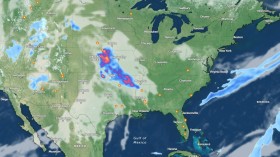Deep beneath the Antarctic ice, researchers have detected neutrinos, the nearly massless subatomic particles encoded with information about cataclysmic events from the far reaches of the galaxy and perhaps beyond.
Using the IceCube Neutrino Observatory, scientists have detected 28 very-high energy particle events that, according to the news release outlining the study, "constitute the first solid evidence for astrophysical neutrinos from cosmic accelerators."
"This is the dawn of a new age of astronomy," stated Francis Halzen, the principal investigator of IceCube and a physics professor at the University of Wisconsin.
While billions of neutrinos pass through every square centimeter of the Earth each second, nearly all of them come from the Sun or the Earth's atmosphere. IceCube is designed to weed those out, identifying those believed to carry insight into distant supernovas, black holes, pulsars and other extreme phenomena that may cause high-energy cosmic rays.
"IceCube is a wonderful and unique astrophysical telescope -- it is deployed deep in the Antarctic ice but looks over the entire universe, detecting neutrinos coming through the Earth from the northern skies, as well as from around the southern skies," said Vladimir Papitashvili of the National Science Foundation (NSF) Division of Polar Programs.
The 28 high-energy neutrinos, detected between 2010 and 2012, could not be explained by any other neutrino fluxes, such as those from atmospheric neutrinos or other high-energy events.
Published in the journal Science, the findings are already improving research on the subject.
"From hints in earlier IceCube analyses, we have used improved analysis methods and more data to make a significant step forward in our search for the elusive astrophysical signal," said collaboration spokesperson Olga Botner of Uppsala University. "We are now working hard on improving the significance of our observation, and on understanding what this signal means and where it comes from.
© 2024 NatureWorldNews.com All rights reserved. Do not reproduce without permission.


![Roundworms with Short Memories 'Stop Forgetting' When Frozen or Given Lithium [Study]](https://1471793142.rsc.cdn77.org/data/thumbs/full/70295/280/157/50/40/roundworms-with-short-memories-stop-forgetting-when-frozen-or-given-lithium-study.jpg)


